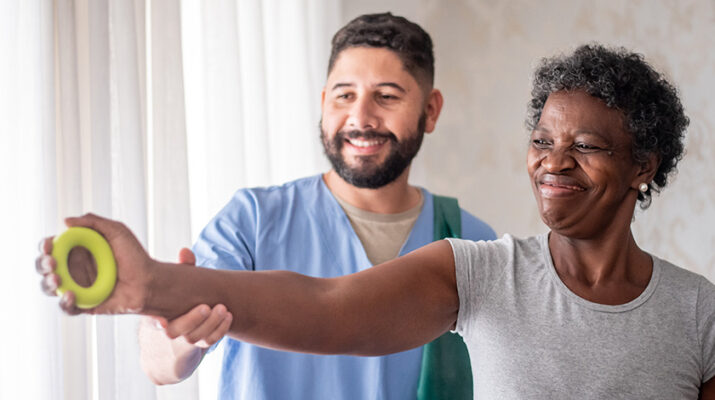In-home visits by PTs grow in Rochester area
By Deborah Jeanne Sergeant
Getting to a physical therapy appointment challenges some patients more than others. Whether it’s transportation, physical frailty, social anxiety, deconditioning or scheduling, patients now can call on a number of mobile physical therapy practices serving the greater Rochester area.
Matt Berliner, who holds a doctorate in physical therapy and manages the physical therapy department at Jewish Senior Life in Rochester, believes that at-home physical therapy can help move patients along the rehabilitation spectrum.
“It gives us a look as to how they function in their homes and we can look at things like trip hazards like throw rugs,” he said. “We also look at showers to see if the patient needs a walk-in shower or if the patient needs accommodation for the toilet seat height. We also give home exercises like range of motion. It helps them get their exercise endurance up to get out patient PT.”
Berliner views in-home PT as a bridge to standard out patient PT in the office, where more equipment is available. But regardless of where the PT happens, completing the program and getting people moving is what is most important, he said.

Lindsey Chase, physical therapist at Thrive in Rochester, sees patients only in a non-clinical setting. She likes that unlike at an office, her sessions are always one on one and can last an hour, which allows her plenty of time to make progress.
“A big advantage is the fact that we can use their own furniture, like their couch or dining room chairs,” Chase said. “People with Parkinson’s tend to freeze up in certain doorways. We can work through that. We can practice movement in the place where they spend 90% of their time.”
It’s also helpful that patients—many of whom are in ill health-do not have to wait in a waiting room, potentially exposing them to communicable illnesses.

Judy Mariotti, who holds a doctorate of physical therapy and owns PT At Home with Judy in Webster, has worked in physical therapy for 38 years in a variety of settings. Like Chase, she prefers the more intimate environment of the home over the office.
“Patients tell me when they go to a clinic, they’re put on equipment and the physical therapist goes to see another patient,” Mariotti said. “With home visits, you’re with the patient the whole time and your undivided attention is with them.”
She can also chat with family members present to know how the patient is doing on compliance with restrictions and performing exercises. She uses portable devices like resistance bands and whatever is available in the home, such as a step with a handrail nearby for step-up exercises.
Molly Greenbaum, physical therapist, represents another mobile PT practice as owner of Stronger Today Physical Therapy in Rochester.
“When it comes to out patient physical therapy services in the home, people don’t realize that you don’t need to have a recent hospitalization or recent surgery,” Greenbaum said. “It can be for people who have a new ache or pain or has noticed more difficulty doing activities of daily living or experienced a recent fall or are overall feeling more unsteady.”
Making PT more convenient helps patients stick with their regimen and helps them make better gains.
Holding physical therapy at sites other than the office can help patients who want to return to their normal activities. Greenbaum can help patients strategize how to run errands safely if she accompanies them as part of their physical therapy, such as going to the grocery store together.
“It can be intimidating but with the guidance and having someone work with you and start with you where you are and challenge you, you can benefit,” she said.

Bryan Guzski, who earned a doctorate in physical therapy and owns Motive Physical Therapy in Rochester, brings physical therapy to patients’ homes, businesses, gyms and “anywhere that the patient would like to be seen.”
He finds it easier to see patients where they experience issues and adjust in real time. “This allows patients to get better care and downstream, require fewer visits, saving them time and money with a better outcome.”
One example is observing the ergonomics of a person’s office. Guzski said that many people don’t realize that their setup is not ideal and contributes to worsening their issue.
“The person who works out in their basement and has problems with their home workout — we can look at the equipment they’re using and make suggestions in real time,” he added.
Guzkski’s business operates outside of insurance networks, but some insurers will reimburse for visits.
New York is a direct access state, meaning patients may have 10 visits or up to 30 days of seeing a physical therapist without a referral from a physician. This provision helps patients receive care right away without another doctor visit and a needless copay.

